Baking Basics: How to Make Perfect Cakes and Cookies Every Time


Essential Baking Tools and Equipment
Oven
When it comes to baking, the oven is the heart of your kitchen. It's essential to have a reliable oven that can maintain the desired temperature throughout the baking process. Whether you choose a conventional oven or a convection oven, make sure it has accurate temperature control and even heat distribution. This will ensure that your baked goods come out perfectly every time.
Mixing Bowls and Spoons
No baking adventure is complete without a set of mixing bowls and spoons. These tools are the foundation of any recipe. Invest in a variety of sizes for your mixing bowls to accommodate different recipes. Look for bowls that are sturdy, easy to clean, and have a non-slip bottom for stability. When it comes to spoons, opt for both solid and slotted versions for different mixing tasks. Silicone or stainless steel spoons are durable and heat-resistant, making them ideal for baking.
Measuring Cups and Spoons
Precision is key in baking, so having accurate measuring cups and spoons is a must. Look for measuring cups made of clear, durable material, such as glass or plastic, with easy-to-read markings. Stainless steel measuring spoons are a great choice for accuracy and longevity. Having both liquid and dry measuring cups will ensure that you can measure all your ingredients accurately, from flour to milk to oils.
With these essential baking tools and equipment, you'll be well-prepared to embark on your baking journey. Remember to always follow the recipe instructions, enjoy the process, and have fun experimenting with different flavors and techniques. Happy baking!

Common Baking Ingredients
Flour
When it comes to baking, flour is one of the key ingredients you'll need. It provides structure to baked goods and affects their texture. All-purpose flour is a versatile option that works well for most recipes, while cake flour is lighter and more refined, perfect for delicate cakes. Experiment with different types of flour to achieve the desired results.
Sugar
Sugar adds sweetness and moisture to baked goods. There are various types of sugar, including granulated sugar, brown sugar, and powdered sugar. Granulated sugar is the most commonly used and can be substituted with alternatives like honey or maple syrup for a different flavor profile.
Butter and Margarine
Butter and margarine contribute richness and flavor to baked goods. Butter adds a creamy texture and a delicious taste, while margarine is a suitable alternative for those who prefer a non-dairy option. It's important to follow the recipe instructions on whether to use softened or melted butter.
Eggs
Eggs play a critical role in baking by providing structure, moisture, and richness. They act as a binding agent and contribute to the overall texture and taste of baked goods. If you're looking for an egg substitute, options like applesauce, mashed bananas, or yogurt can be used, but results may vary.
Baking Powder and Baking Soda
These leavening agents are essential for achieving a light and fluffy texture in baked goods. Baking powder is a combination of baking soda, cream of tartar, and a stabilizer, while baking soda requires an acidic ingredient to activate its leavening properties. Make sure to check the expiration dates on these ingredients to ensure they are still active.
Remember, baking is a creative process, so don't be afraid to experiment with different ingredients and techniques. Enjoy the journey and have fun baking!

Baking Techniques and Methods
Are you ready to elevate your baking skills? Whether you're a beginner or just looking to brush up on the basics, understanding different baking techniques and methods is essential. Here are three key methods that will help you create delicious treats in no time.
Creaming Method
Become a master of light and fluffy cakes with the creaming method. This technique involves combining softened butter and sugar until light and creamy. Adding eggs one at a time and mixing well after each addition helps incorporate air into the batter, resulting in a tender texture. Finally, alternate adding dry ingredients and liquid, mixing until just combined. This method is ideal for creating cakes, cookies, and muffins.
Folding Method
Perfect for delicate ingredients, the folding method ensures a light and airy result. Start by gently folding in whipped egg whites or whipped cream into a heavier batter. Using a spatula, cut through the center of the mixture, then lift and fold it over. Repeat until the ingredients are well combined. This method works well for dishes like soufflés, mousse, and chiffon cakes.
Whisking Method
Whip up airy and voluminous desserts with the whisking method. Begin by whisking eggs and sugar together until pale and thick. Gradually add in dry ingredients while continuing to whisk. This method creates a light texture suitable for recipes such as sponge cakes, meringues, and pancakes.
So, whether you're making a cake, experimenting with mousse, or whipping up pancakes, mastering these techniques will

Basic Baking Recipes
Classic Chocolate Chip Cookies
Welcome to the delightful world of baking! If you're new to baking, one of the best recipes to start with is classic chocolate chip cookies. Here's a simple recipe to satisfy your sweet tooth:
Ingredients:
- 1 cup butter, softened
- 3/4 cup granulated sugar
- 3/4 cup brown sugar
- 2 teaspoons vanilla extract
- 2 large eggs
- 2 1/4 cups all-purpose flour
- 1 teaspoon baking soda
- 1/2 teaspoon salt
- 2 cups chocolate chips
Instructions:
- Preheat your oven to 375°F (190°C).
- In a large bowl, cream the softened butter, granulated sugar, and brown sugar until light and fluffy.
- Beat in the vanilla extract and eggs until well blended.
- In a separate bowl, whisk together the flour, baking soda, and salt.
- Gradually add the dry ingredients to the creamed mixture, mixing well.
- Stir in the chocolate chips.
- Drop rounded tablespoonfuls of dough onto ungreased baking sheets.
- Bake for 9-11 minutes or until golden brown.
- Allow the cookies to cool on the baking sheets for a few minutes before transferring them to wire racks to cool completely.
Vanilla Cupcakes with Buttercream Frosting
Ready to take your baking skills to the next level? Vanilla cupcakes with buttercream frosting are a classic and crowd-pleasing treat. Here's a simple recipe to get you started:
Ingredients:
- 1 3/4 cups all-purpose flour
- 1 1/2 teaspoons baking powder
- 1/2 teaspoon salt
- 1/2 cup unsalted butter, softened
- 1 cup granulated sugar
- 2 large eggs
- 1 teaspoon vanilla extract
- 3/4 cup milk
Instructions:
- Preheat your oven to 350°F (175°C) and line a cupcake pan with paper liners.
- In a medium bowl, whisk together the flour, baking powder, and salt.
- In a separate bowl, cream the softened butter and granulated sugar until light and fluffy.
- Beat in the eggs one at a time, followed by the vanilla extract.
- Gradually add the dry ingredients to the creamed mixture, alternating with the milk. Begin and end with the dry ingredients.
- Divide the batter evenly among the cupcake liners, filling each about two-thirds full.
- Bake for 18-20 minutes or until a toothpick inserted into the center comes out clean.
- Let the cupcakes cool in the pan for 5 minutes, then transfer them to a wire rack to cool completely.
- Once the cupcakes are completely cooled, frost them with your favorite buttercream frosting.
Homemade Bread
Ready to tackle the art of bread-making? There's nothing quite like the smell and taste of homemade bread. Here's a basic recipe to get you started on your bread-making journey:
Ingredients:
- 4 cups all-purpose flour
- 2 teaspoons active dry yeast
- 2 teaspoons salt
- 2 tablespoons granulated sugar
- 1 3/4 cups warm water
Instructions:
- In a large bowl, combine the flour, yeast, salt, and sugar.
- Gradually add the warm water while stirring with a wooden spoon or silicone spatula until a sticky dough forms.
- Cover the bowl with plastic wrap and let the dough rise in a warm place for about 2 hours or until doubled in size.
- Preheat your oven to 450°F (230°C) and place a Dutch oven or oven-safe pot with a lid inside to preheat as well.
- Once the dough has risen, carefully remove the hot pot from the oven and transfer the dough into it.
- Cover the pot with the lid and bake for 30 minutes.
- Remove the lid and bake for an additional 10-15 minutes or until the bread is golden brown.
- Carefully remove the bread from the pot and let it cool on a wire rack before slicing.
Now that you have these basic baking recipes, it's time to roll up your sleeves, preheat the oven, and let your baking adventures begin! Happy baking!

Troubleshooting Common Baking Problems
Flat or Sunken Cakes
If you've ever baked a cake only to have it turn out flat or sunken in the middle, don't despair! There are a few common reasons for this problem and simple solutions to help you achieve the perfect cake every time.
-
Incorrect Oven Temperature: Make sure your oven is preheated to the correct temperature before baking. An oven that is too hot can cause your cake to rise too quickly and then collapse in the center.
-
Overmixing the Batter: Be careful not to overmix your cake batter. Overmixing can lead to too much air being incorporated, causing the cake to rise too quickly and then sink in the middle.
-
Expired Leavening Agents: Check the expiration dates on your baking powder and baking soda. If they are expired, they may not provide enough lift, resulting in a flat cake.
-
Opening the Oven Too Soon: Avoid opening the oven door during baking, especially in the first half of the baking time. Opening the door can cause a sudden drop in temperature, resulting in a collapsed cake.
-
Underbaking: Make sure your cake is baked for the recommended time. Underbaking can cause the center to collapse once it's out of the oven.
By addressing these common issues, you can troubleshoot and prevent flat or sunken cakes. Remember to follow the recipe instructions carefully, and don't be discouraged if you encounter a baking problem. With a little practice and understanding, you'll soon be baking perfect cakes every time!

Baking Tips and Tricks
Preheating the Oven
When you're ready to dive into the wonderful world of baking, one of the first things you need to master is preheating the oven. This step is crucial as it ensures that your baked goods cook evenly and turn out perfectly every time. Before you start mixing ingredients, always preheat your oven to the specified temperature mentioned in the recipe. This allows the oven to reach the desired temperature, giving you consistent and reliable results.
Properly Measuring Ingredients
Accurate measurement of ingredients plays a vital role in baking success. To ensure your baked goods turn out just right, it's important to measure ingredients properly. Use a set of measuring cups for dry ingredients like flour, sugar, and cocoa powder. Spoon the ingredient into the cup and level it off with a straight edge. For liquids, use a liquid measuring cup placed on a flat surface and read it at eye level. This helps you avoid adding too much or too little of an ingredient, which can affect the texture and taste of your baked goods.
Remember, baking is both an art and a science, and these basic tips and tricks will help you get started on the right foot. So, preheat that oven and measure your ingredients with precision – it's time to whip up some delicious treats!
Benefit Explanation
Preheating the Oven – Preheating the oven ensures that your baked goods cook evenly and turn out perfectly every time.
Properly Measuring Ingredients – Accurate measurement of ingredients is vital in baking success. It helps you avoid adding too much or too little of an ingredient, which can affect the texture and taste of your baked goods.

Decorative Techniques for Baked Goods
Icing and Frosting Techniques
If you're a beginner baker or someone looking to improve their baking skills, learning decorative techniques for your baked goods can take your creations to the next level. Whether it's for a special occasion or just to add some flair to your everyday treats, here are some icing and frosting techniques to try:
-
Buttercream Piping: Use a piping bag fitted with a decorative tip to create beautiful patterns and designs on your cakes and cupcakes. From rosettes to swirls, the possibilities are endless.
-
Fondant Decorations: Fondant is a versatile icing that can be rolled, shaped, and molded into various designs. Use it to create intricate cake toppers, flowers, or even characters for themed cakes.
-
Marbled Icing: Create a marbled effect by combining different colors of icing and gently swirling them together. This technique adds a fun and artistic touch to your baked goods.
-
Brush Embroidery: This technique involves using a small paintbrush and edible food coloring to create delicate, lace-like patterns on your cookies or cakes. It's a simple yet elegant way to elevate your baked goods.
Remember, practice makes perfect when it comes to decorative techniques. Start with simple designs and gradually work your way up to more intricate ones. Don't be afraid to experiment and add your own personal touch to your creations.
So, next time you're baking, have fun and get creative with these icing and frosting techniques. Your baked goods will not only taste delicious but also look absolutely stunning.

Conclusion
Congratulations! You've taken your first steps towards becoming an amazing baker. Baking can be a fun and rewarding hobby, and with the right knowledge, you'll be whipping up delicious treats in no time. Remember, practice makes perfect, so don't be discouraged if your first few attempts are less than perfect. Keep experimenting, learning, and most importantly, enjoy the process!
Frequently Asked Questions
-
Can I substitute ingredients in baking? Yes, you can often substitute ingredients in baking, but it's important to note that it may affect the taste and texture of the final product. Some common substitutions include using Greek yogurt instead of buttermilk or applesauce instead of oil.
-
Do I need to preheat the oven? Yes, preheating the oven is essential in baking. It ensures that the oven reaches the correct temperature before you put your baked goods in, resulting in more consistent and evenly baked treats.
-
Why did my cake sink in the middle? There are several possible reasons for a cake sinking in the middle, including underbaking, overmixing, or opening the oven door too soon. Ensuring proper measurements, mixing techniques, and not opening the oven door until the cake is set can help prevent this issue.
-
How can I tell if my bread is done baking? The best way to determine if bread is done baking is by checking its internal temperature. It should reach around 190-200 degrees Fahrenheit (88-93 degrees Celsius) for most bread recipes.
-
Can I freeze baked goods? Yes, many baked goods can be frozen for future enjoyment. Make sure to cool them completely before wrapping them in airtight containers or freezer bags. Label them with the date to keep track of when they were made.
Remember, baking is a journey of creativity and deliciousness. Don't be afraid to experiment, try new recipes, and have fun along the way. Happy baking!



